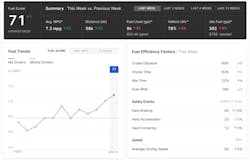Motive: Tracking vehicle, driver data saves fleets up to 13% on fuel
It has never been more critical that fleets maximize their fuel as diesel and gasoline prices have soared. Motive recently published a study showing that businesses can improve their fuel efficiency and optimize their vehicle maintenance by monitoring their idling time, driving behavior, and fleet health, and then use their resources to strengthen deficiencies.
In the study, Motive analyzed more than 800 commercial fleets across a two-year period beginning in January 2020, identified what top fleets with the best fuel performance increase did to improve their efficiency, and measured the impact of their tactics. To do so, Motive focused on Class 8 vehicles and only used customer data from accounts who had at least three such vehicles among their fleets. For greater specificity, they also excluded low-activity accounts and non-interstate accounts.
Top-performing fleets used the Motive Automated Operations Platform insights 300% more often than the average account-holder, using this knowledge to reduce fuel consumption by 13% during the study period. With performance data and coaching opportunities, these fleets achieved savings by improving driving behaviors, averaging a 79% reduction in hard acceleration and a 40% reduction in hard braking. The top fleets also had an increased focus on maintenance, with 80% more inspections compared to other fleets.“The data clearly shows that using telematics data and AI to track and improve performance in commercial fleets can result in significant savings on fuel costs and emission,” said Jai Ranganathan, chief product officer at Motive.
As a result of these gains, the most fuel-efficient fleets saved an estimated 3 million gallons of fuel in 2021 alone. This is equivalent to 31,000 tons of CO2 that were not released into the atmosphere. Additionally, these fleets paid an average price of $3.29 per gallon of fuel during this time, which equates to an average savings of 769 gallons, or $2,530 per vehicle in 2021.
This article originally appeared on FleetMaintenance, the sister site of FleetOwner.

